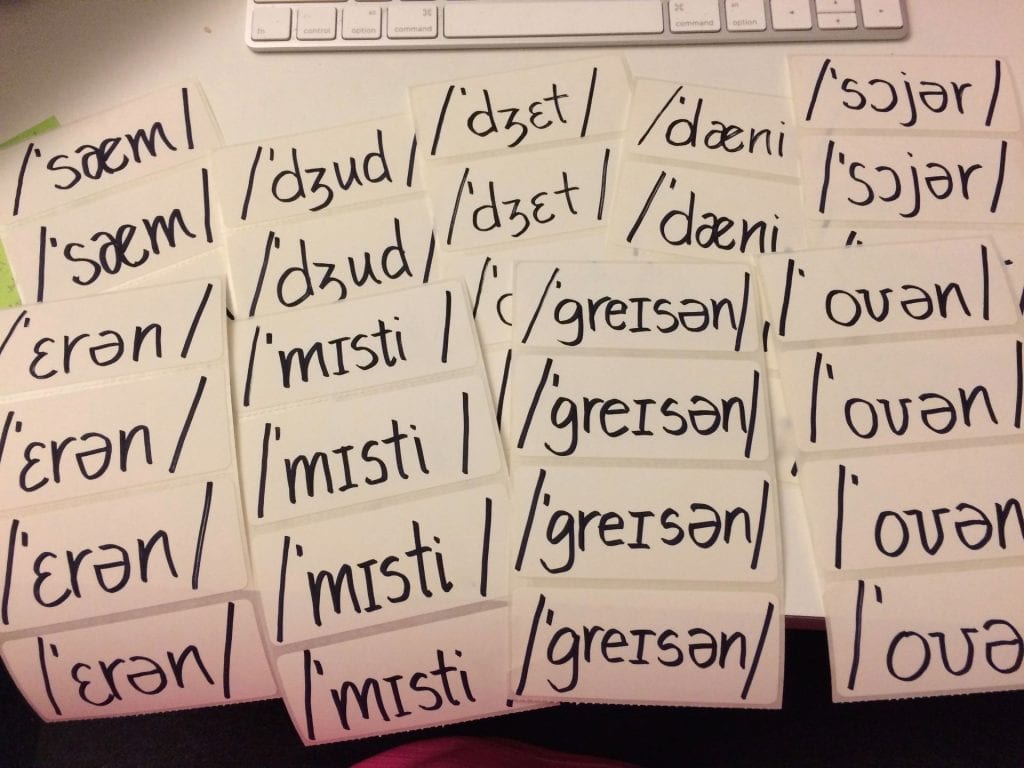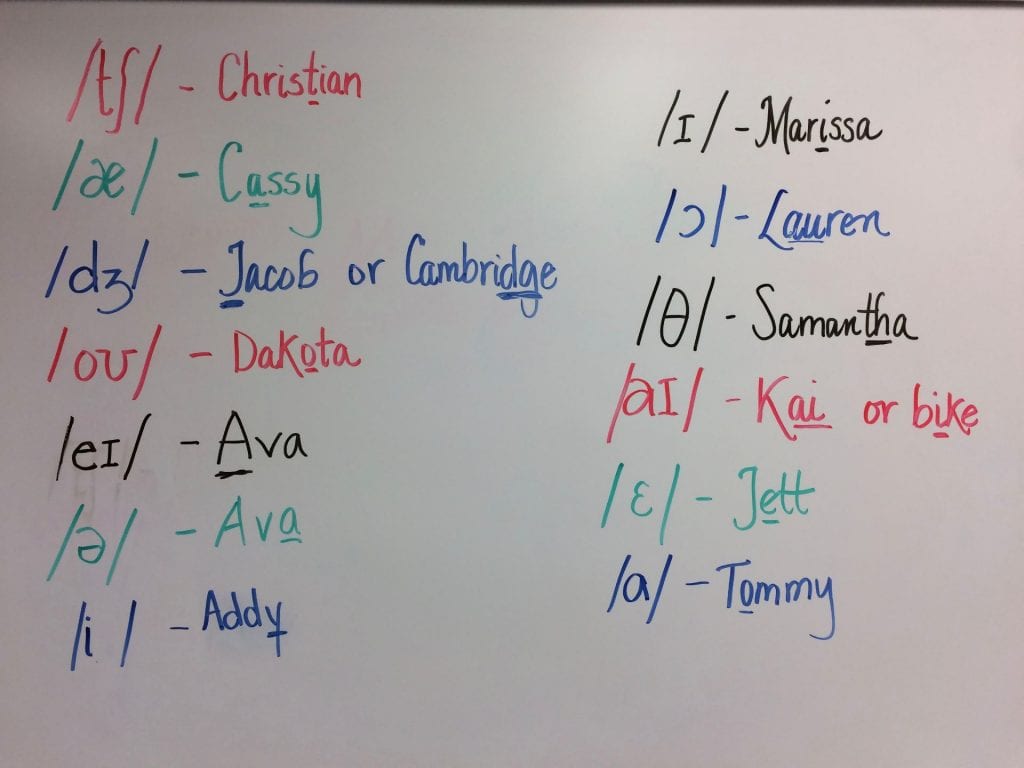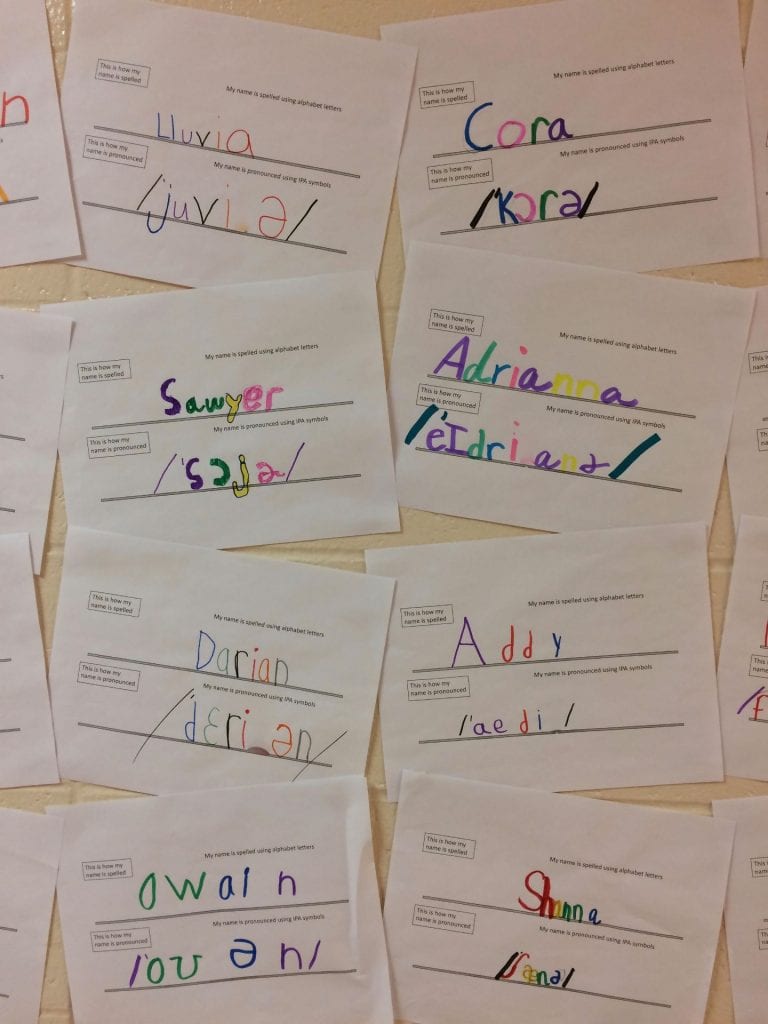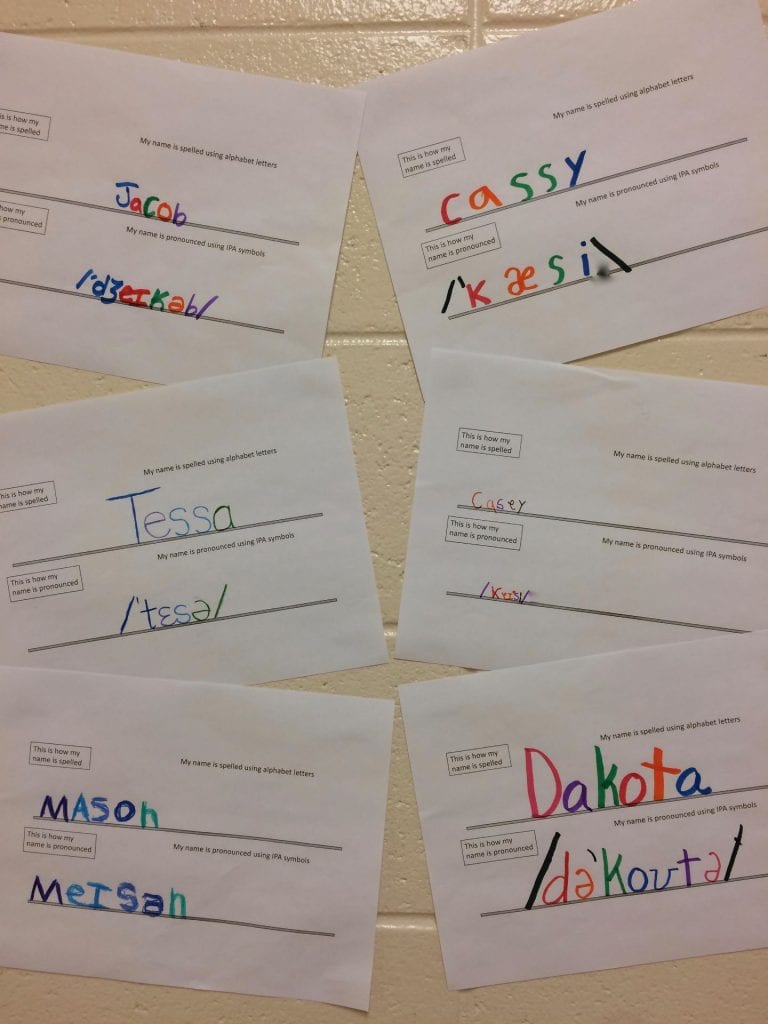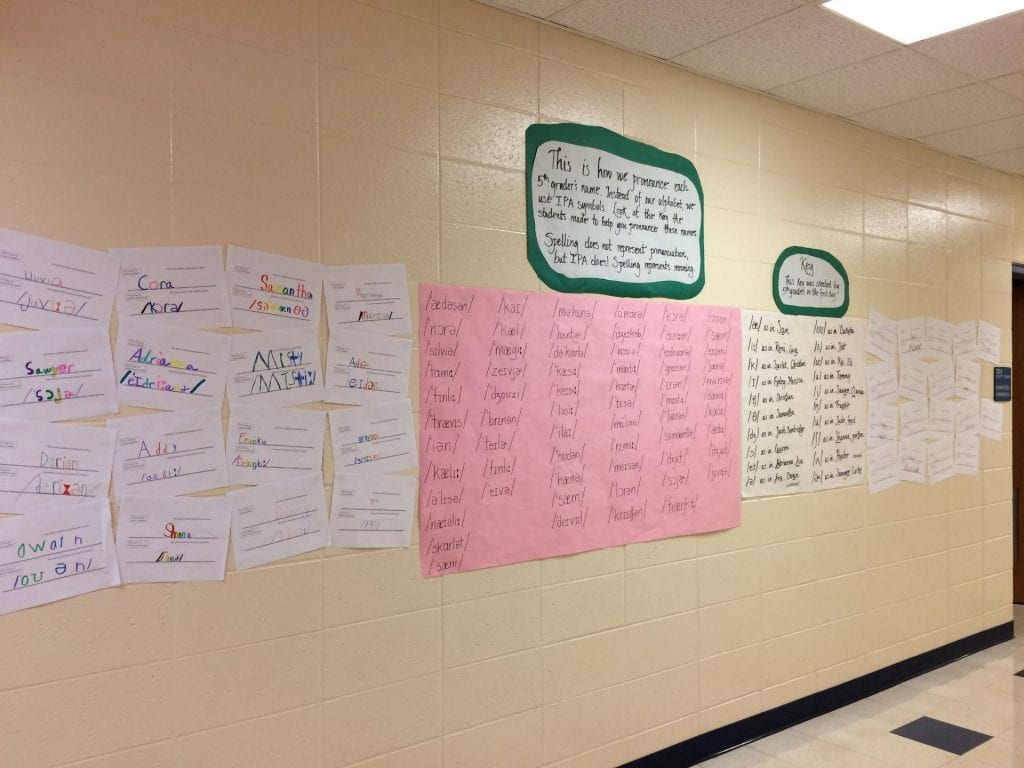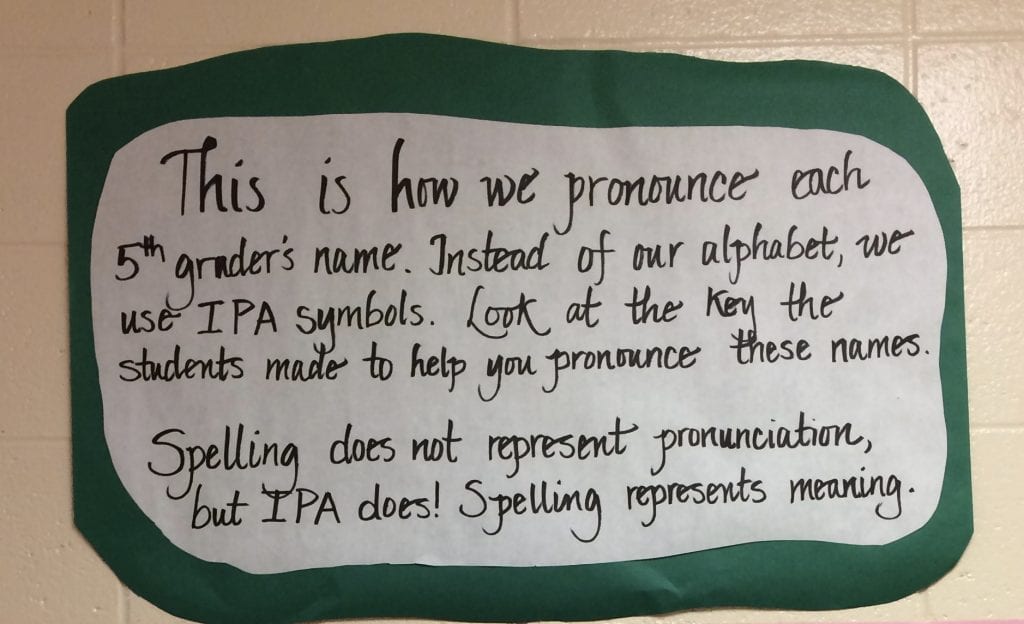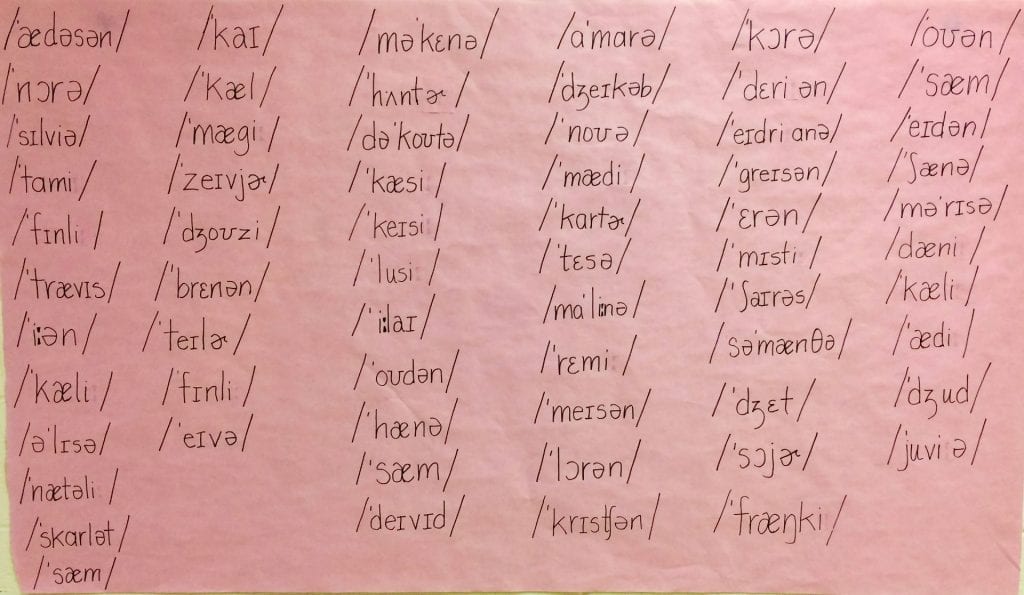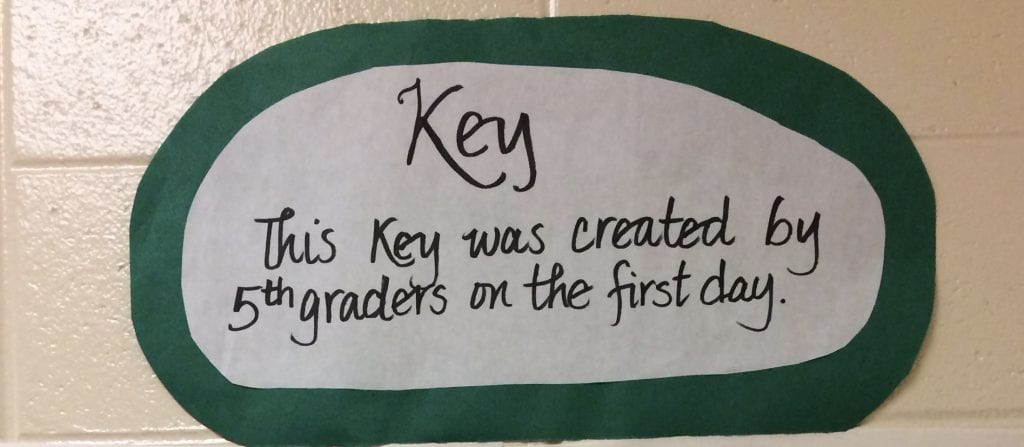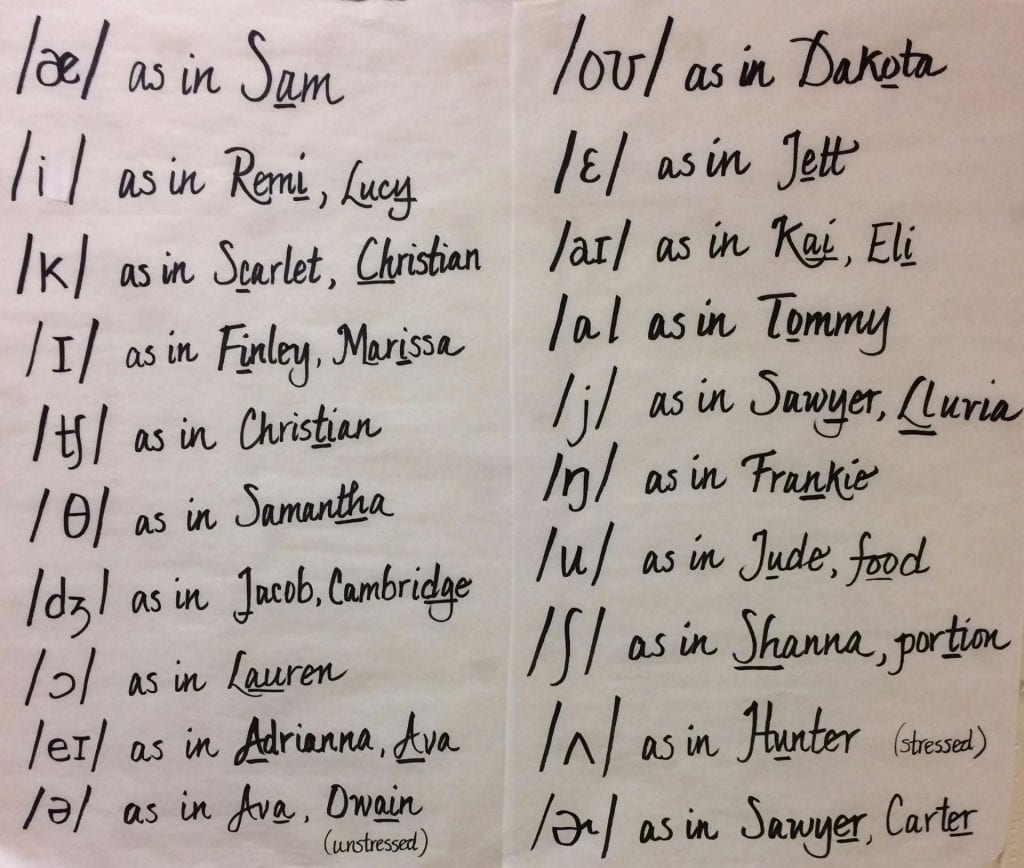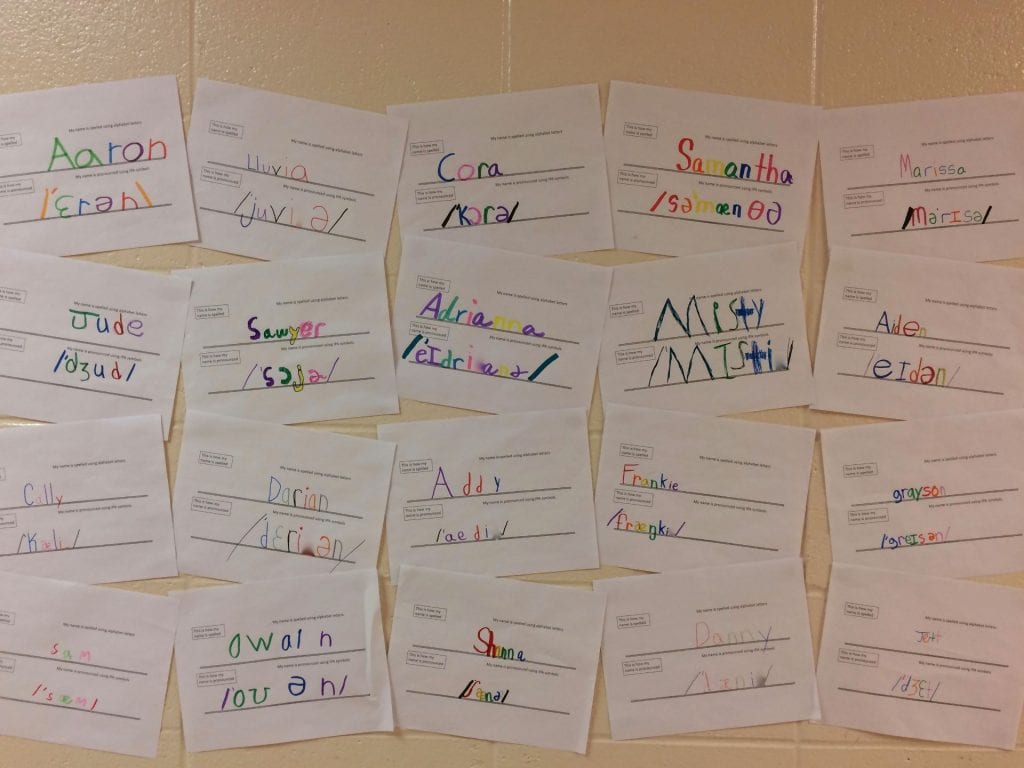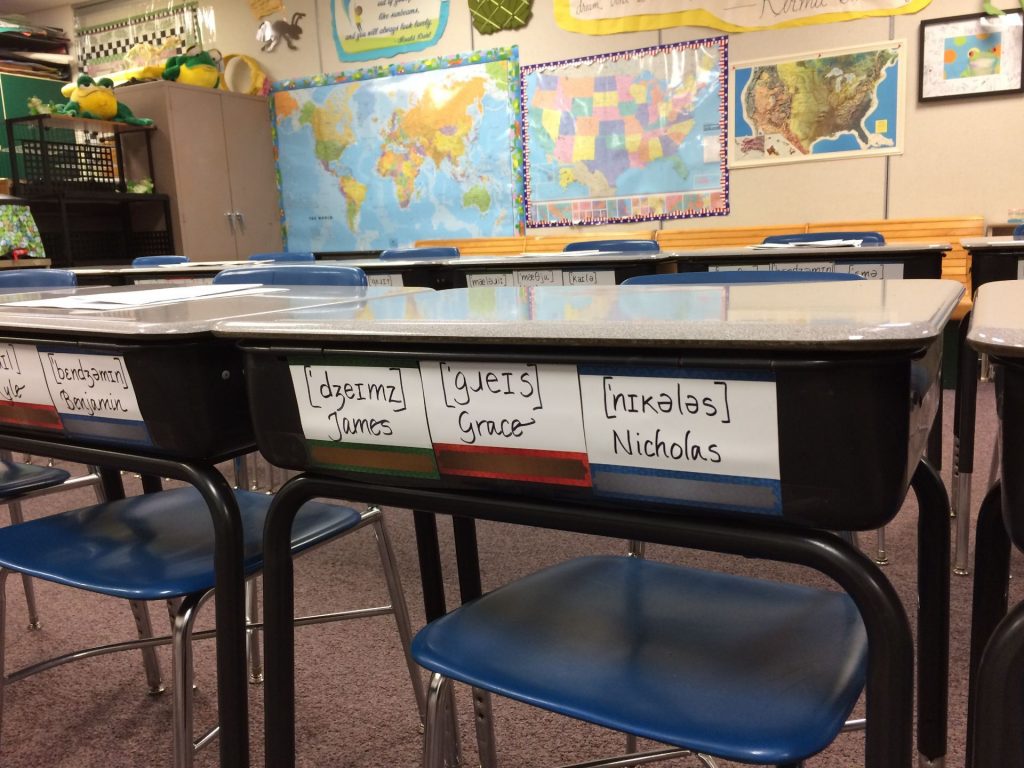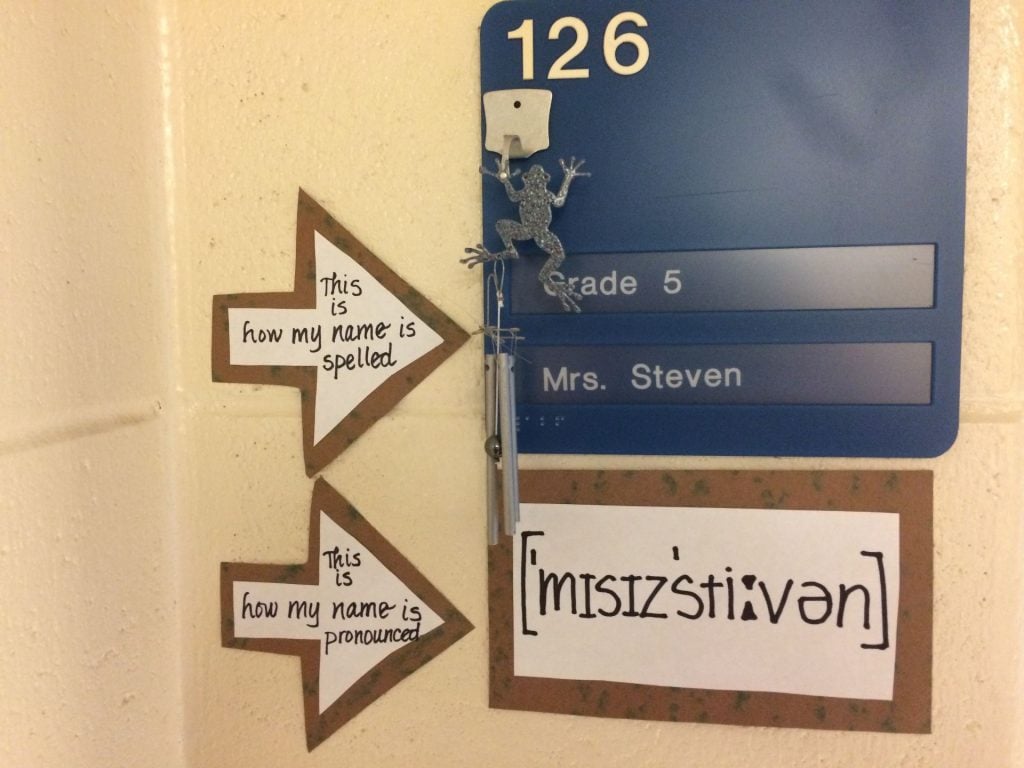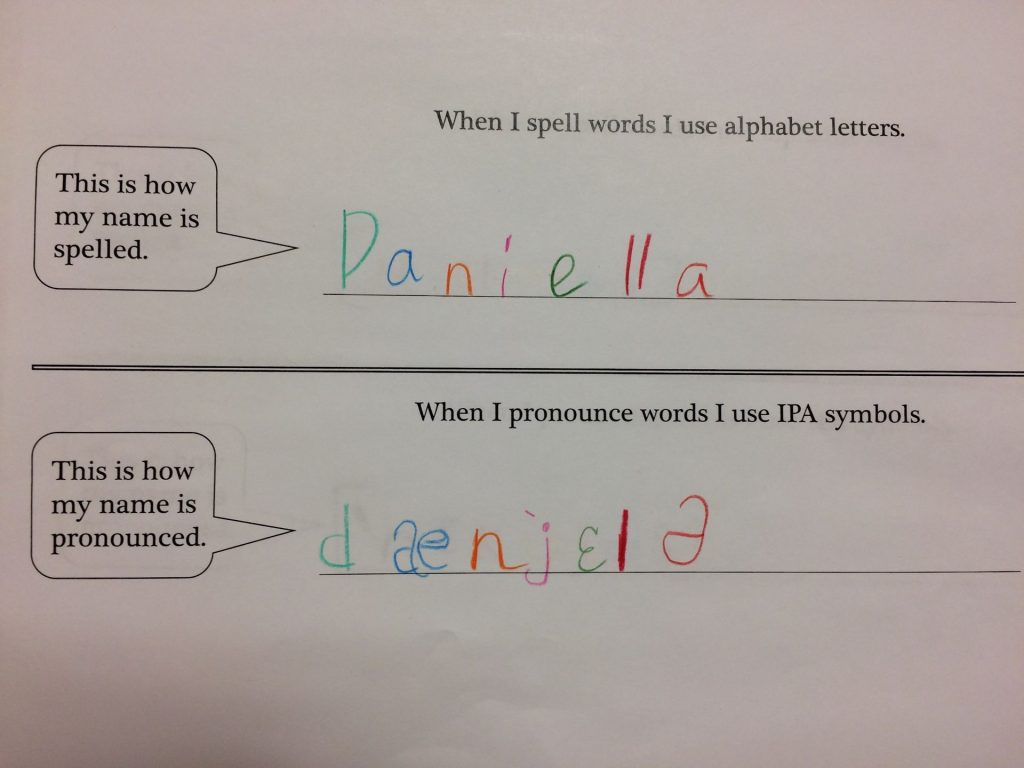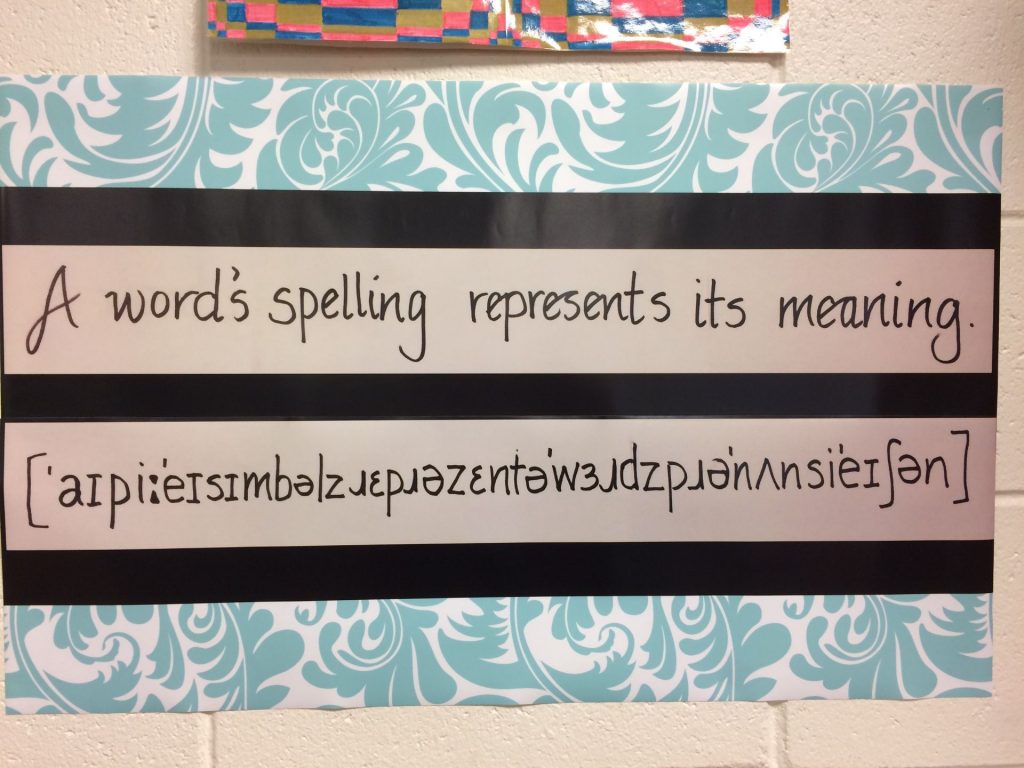For the second year in a row, I began the school year by showing my students how their names would be represented in IPA symbols. The name tags on their desks were IPA representations of their names as well as the name tags on their notebooks. When they came into my room at Open House (five days before the start of the school year), they were a bit bewildered. They didn’t know how to find their desk. I just greeted them with a smile and said that what they were looking at was not a spelling, but rather how pronunciation is represented. “That is the pronunciation of your name,” I said.
Then I showed them which desk was theirs. Most smiled and nodded. A few said nothing, but held perplexed looks on their faces. The parents who asked about it were very intrigued and jokingly asked if they could come and learn too.
Then in preparation for the first day, I made a large poster that included IPA representations of all 64 fifth grade names. I hung it on my Smartboard so that my white board (adjacent) was available to write on. I thought that having that many names in IPA might give the students more opportunity to see certain IPA symbols in many familiar names. Then we could talk about the graphemes we use to represent those pronunciations. Here is the large poster:
Even though it was the first day and I usually begin by introducing myself and the subjects I teach, the students were fired up to start with this. As they came in they looked this poster over and began asking questions.
“Mrs. Steven, I see my name, but that isn’t how I spell it.”
“What language is this?”
“Why do we have to learn this? It looks hard.”
I explained that these are not alphabet letters, even though some of them look exactly like the letters they are used to. These are symbols used to represent pronunciations. They are part of the International Phonetic Association’s system of symbols. The word ‘International’ is there because these symbols are not just used to represent the pronunciation of English words. Many languages can use this system. Some of the symbols might look familiar, but some of them probably don’t.
Then I asked someone to point out a symbol and to say the pronunciation they think it might be representing. Sam was the first to raise his hand and ask about the symbol that looked like an ‘a’ and an ‘e’ all smooshed together. I explained that the symbol æ was once a letter in Old English. It was called ash. It is pronounced like the <a> in <ash>. We recognized that pronunciation in Sam, Maddie, Maggie, Samantha, Addison, Travis, Hannah, Calli, Natalie, Danny, and Addy. Having so many names in IPA was truly helpful.
Next it was Tommy who was curious about the <i> at the end of his name. I told him that it wasn’t the letter <i> that we use in spelling. This symbol represents /i/ and that in his name that pronunciation is spelled with the grapheme <y>. I asked the students to see if that symbol was part of anyone else’s IPA representation. They named Cally, Maggie, Casey, Cassy, Remi, Misty, Addy, and Danny. Then we noticed that /i/ wasn’t always represented with the grapheme <y>. In Remi’s name it was represented with a single <i>, in Casey’s name it was represented by the digraph <ey>, and in Maggie’s name it was the digraph <ie>.
The next to speak up was Scarlet. She said, “You put a <k> in my name, but it is spelled with a <c>.” So I explained that while that IPA symbol looks like a <k>, it isn’t. These symbols are not the alphabet letters we spell with.
“The symbol represents /k/. Is that how you pronounce the <c> in your name?”
“Yes.”
I wrote the letter <c> on the board. I asked if anyone could tell me how to pronounce it. Scarlet immediately said /k/.
“Have you ever seen this letter in a word in which it was not pronounced /k/ but something different?”
Finley raised his hand and said, “What about in city? There it is /s/.”
“Exactly. Using a symbol that we recognize as <c> wouldn’t work in IPA, because we wouldn’t know which pronunciation to use.”
Then we spotted the names Cora, Cally, Carter, Frankie, Christian, Cal, Kai, and Casey that all had /k/ in their pronunciation. I asked about Christian. “Is it just the <c> or is it the <ch> that is represented by the /k/?” Someone recognized that <ch> is pronounced /k/ in chemistry too.
Finley pointed out the symbol that looked like a capital ‘i’. We only found that pronunciation is two other names – Misty and Marissa.
Then someone asked about the weird symbol that was in Christian’s name. In anticipation, I wrote /tʃ/ on the board and pronounced it. I wrote the spelling of his name on the board and asked, “Now which letter in the spelling of his name represents that pronunciation?” Students answered with several guesses, but no one guessed <t> by itself. So I covered up the <ian> part of the spelling and asked how the letter <t> would be pronounced. Everyone said /t/. I asked them to notice how the pronunciation of that <t> changed when it was followed by the <ian>. We then brainstormed the words creature and mention where the letter <t> is also pronounced /tʃ/. “I bet you never thought a <t> could represent anything but /t/. But here is evidence that it can. As we learn more about spelling and pronunciation, you will learn that the letter <t> represents at least one other pronunciation as well!
When the next group of fifth graders came in (we rotate three groups and spend 90 minutes with each group), I erased the board and started an examination of IPA with them. Jacob wondered about the symbol at the beginning of his name. I wrote and then pronounced /dʒ/ on the board. Then I spelled his name next to it. “In your name, what letter represents /dʒ/?” He answered that it was the <j>. “Is that the only spelling that can be pronounced that way?” He quickly answered yes. “Can anyone think of a word with that pronunciation in it?” That’s when the name of our village came up – Cambridge. “In this word, what letter or letters represent /dʒ/?” Lauren recognized it was the <dge> combination. (I’m jumping ahead to what happened with the third group of students when someone recognized that their last name had that pronunciation and it was represented by the grapheme <g>! Look for it in the next picture!)
Next it was time to look at the two symbols (functioning as one) with a pronunciation of /oʊ/ and represented as the letter <o> in the name Dakota. The students wondered why there were two symbols for this one pronunciation, so I asked everyone to pronounce it. Then I said, “Get ready to pronounce the letter <o>. Freeze. Notice the position of your mouth. Now pronounce it. As I heard them finishing, I asked them to freeze again and notice that their mouth was not in exactly the same position. We did this a few more times so that everyone could feel that our mouth glides to a new position as we pronounce the letter <o>. This is called a vowel glide. Now you can see why the two IPA symbols are used as one to represent the pronunciation of this letter. We looked around to see if other names had this pronunciation. We found Oden, Noah, and Owain.
Ava was the next one to raise her hand. “My name begins with an <a> and ends with an <a>, yet each <a> has a different IPA symbol. Why is that?”
“Well, do we pronounce them the same way?”
“No, we don’t,” she replied.
We focused first on the the first pronunciation in her name. I asked everyone to say the letter <a>. Just as we did with <o>, I asked them to notice the way our mouths begin in one position and finish in another. “This is another vowel glide. We see this one pronunciation represented by an IPA symbol that looks like two symbols. Who else has this pronunciation in their name?”
The students found Adrianna, Casey, Taylor, Grayson, Aiden, Xaiver, Mason, and Jacob. It was interesting to note the graphemes and digraphs that represented this pronunciation in the students’ names.
I pointed out the stress marks in each name and we noted that not everyone had a stress mark at the beginning of their name. We practiced saying the names and feeling the stress. We noted the difference in pronunciation between /məˈkɛnə/ and /ˈmɑkɛnə/. Even though noticing stress is completely new to these students, this was a first step, and they recognized how it made a difference in Makenna’s name.
As we continued, the students kept using their own names and the names of their classmates to decipher the IPA symbols and the pronunciations they represented. Along the way we talked about the symbol known as schwa. We found this pronunciation symbol in many names including Norah, Addison, Sylvia, Alyssa, Natalie, Ian, Scarlet, Hannah, Shiras, Darien, and Shanna. Again, we noticed that this pronunciation could be represented by several graphemes and digraphs. I shared with them that the schwa is unstressed in a pronunciation. It does not get the punch that a stressed vowel would get. We compared the /ʌ/ in Hunter to the /ə/ in Cora, and tried to feel the difference between that pronunciation being stressed in Hunter and unstressed in Cora.
By the end of the day, there were very few symbols that had not been discussed. The students left the room abuzz with their new understanding. I told them I would combine the observations from each class and make a key that we could all use to understand these IPA symbols as we move forward in our learning. My! It was a good day!
The next day I wanted to revisit what we had talked about and then take it a step further. I modeled writing a spelling of someone’s name on the board and then putting the IPA symbols underneath. But as I did so, I used one color to represent the grapheme and the corresponding IPA symbol that represented that grapheme. I used another color to pair up the next grapheme (or digraph) with the IPA symbol that represented it. I kept going, switching colors, until the name was spelled and the pronunciation was represented. Then I asked the students to do the same thing with their own name in their notebooks. When I had checked it, they wrote it out on larger paper so we could hang these in the hallway and share what we are learning!
As the first students finished, they asked me what they should do next. I sent them to the large poster and had them practice pronouncing everyone’s name. They were so proud that they could do it now! We finished up with a discussion about the fact that spelling doesn’t usually help us know how to pronounce a word. We used several names including Aaron’s as an example of that. But now we understand IPA! We have a reliable system that will represent pronunciation! That means that we can look to spelling to represent a word’s meaning!
*****Right now those are words crafted into a statement that doesn’t mean much to my students. I know that. But in these two days we put some solid bricks in the foundation of our understanding of the English spelling system. The rest will come. It takes presenting evidence over and over for them to finally get that each word has a story and that it reveals that story and its meaning through its spelling. One day at a time. Our understanding has begun!
Below are the pictures of our hallway display. We have seen many people stop to take a look. That makes us happy!

